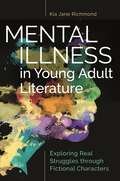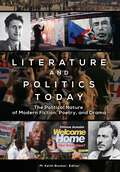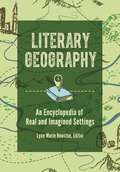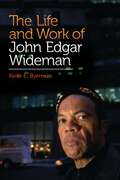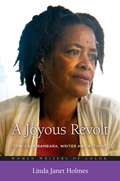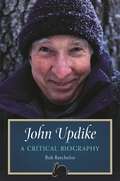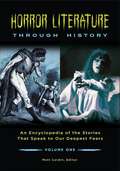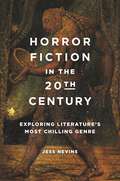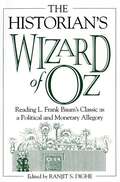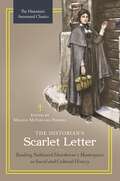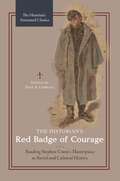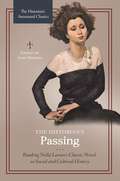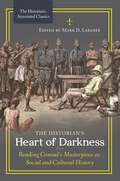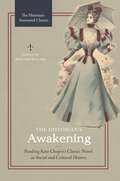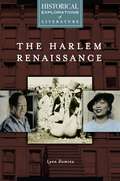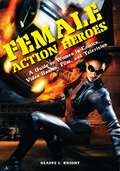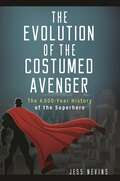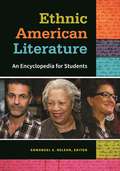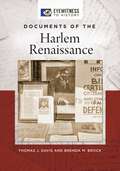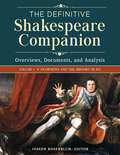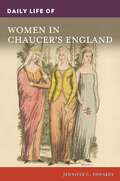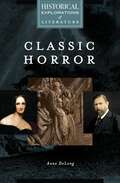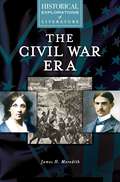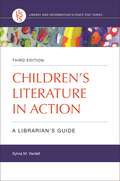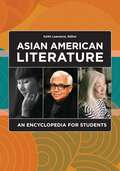- Table View
- List View
Mental Illness in Young Adult Literature: Exploring Real Struggles through Fictional Characters
by Kia Jane RichmondThis book explores how mental illness is portrayed in 21st-century young adult fiction and how selected works can help teachers, librarians, and mental health professionals to more effectively address the needs of students combating mental illness.Mental Illness in Young Adult Literature: Exploring Real Struggles through Fictional Characters highlights American young adult literature published since the year 2000 that features characters grappling with mental illness. Chapters focus on mental disorders identified by the most recent Diagnostic and Statistical Manual of Mental Disorders (DSM-5), including anxiety, depression, bipolar disorder, schizophrenia, ADHD, and OCD. Each chapter begins with a description of a mental illness that includes its prevalence, demographic trends, symptoms, related disorders, and treatment options before examining a selection of young adult texts in depth. Analysis of the texts explores how a mental illness manifests for a particular character, how that character perceives him- or herself and is perceived by others, and what treatment or support he or she receives. The connections between mental illness and race, ethnicity, gender, sexuality, and identity are examined, and relevant research from education, psychology, and adolescent health is thoroughly integrated. Each chapter also provides a list of additional readings. An appendix offers strategies for integrating young adult literature into health curricula and other programs.
Literature and Politics Today: The Political Nature of Modern Fiction, Poetry, and Drama
by M. Keith Booker, EditorFocusing on the intersection of literature and politics since the beginning of the 20th century, this book examines authors, historical figures, major literary and political works, national literatures, and literary movements to reveal the intrinsic links between literature and history.Literary works have often engaged political issues, and many political writings give close attention to literary concerns. This encyclopedia explores the complex relationship between literature and politics through detailed entries written by expert contributors on authors, historical figures, major literary and political works, national literatures, and literary movements, covering specific themes, concepts, and genres related to literature and politics from the 20th century to the present. The work covers cover authors that include Margaret Atwood, James Baldwin, Philip K. Dick, W.E.B. Du Bois, William Faulkner, Ernest Hemingway, Jack London, Toni Morrison, George Orwell, John Steinbeck, and Virginia Woolf, just to mention a few.International in scope, Literature and Politics Today: The Political Nature of Modern Fiction, Poetry, and Drama covers writing ranging from the beginning of the 20th century to the present, with special emphasis on works written in English. The content of the some 150 alphabetically arranged entries is ideal for high school students working on assignments involving literature to explore such current yet historically ongoing social issues as censorship and propaganda. This book is appropriate for public libraries where it will serve to support student research and to help general readers learn more about enduring political concerns through literary works. Academic libraries will find this reference a valuable guide for undergraduates studying literature, history, political science, law, and other disciplines.
Literary Geography: An Encyclopedia of Real and Imagined Settings
by Lynn Marie HoustonThis reference investigates the role of landscape in popular works and in doing so explores the time in which they were written.Literary Geography: An Encyclopedia of Real and Imagined Settings is an authoritative guide for students, teachers, and avid readers who seek to understand the importance of setting in interpreting works of literature, including poetry. By examining how authors and poets shaped their literary landscapes in such works as The Great Gatsby and Nineteen Eighty-Four, readers will discover historical, political, and cultural context hidden within the words of their favorite reads. The alphabetically arranged entries provide easy access to analysis of some of the most well-known and frequently assigned pieces of literature and poetry. Entries begin with a brief introduction to the featured piece of literature and then answer the questions: "How is literary landscape used to shape the story?"; "How is the literary landscape imbued with the geographical, political, cultural, and historical context of the author's contemporary world, whether purposeful or not?" Pop-up boxes provide quotes about literary landscapes throughout the book, and an appendix takes a brief look at the places writers congregated and that inspired them. A comprehensive scholarly bibliography of secondary sources pertaining to mapping, physical and cultural geography, ecocriticism, and the role of nature in literature rounds out the work.
The Life and Work of John Edgar Wideman
by Keith E. ByermanChallenging. Successful. Controversial. All terms used to accurately describe African American novelist and autobiographer John Edgar Wideman. This book examines his life and work—and the connections between them.The Life and Work of John Edgar Wideman is ideal for readers who might not be familiar with Wideman's work or those who may have been intimidated by descriptions of his writings. Through its coverage of Wideman's life from several generations back to the present and explanations of how Wideman makes use of life experiences, this book breaks down barriers for new readers and enables them to better relate and connect to his writing. Author Keith E. Byerman discusses Wideman's book-length works of fiction and nonfiction, as well as some of his shorter, journalistic pieces. The book emphasizes how Wideman integrates family and personal experience into what is typically labeled postmodern writing, and explains how he has evolved as a public intellectual who supplies shrewd commentary on subjects such as the prison system, terrorism, and the role of sports in American society.
A Joyous Revolt: Toni Cade Bambara, Writer and Activist (Women Writers of Color)
by Linda Janet HolmesAt long last—a book-length biography celebrates Toni Cade Bambara, a seminal literary, cultural, and political figure who was among the most widely read and frequently reviewed of the well-regarded black women writers to emerge in the 1970s.A Joyous Revolt: Toni Cade Bambara, Writer and Activist is the first-ever, full-length biography of a trailblazing artist who championed black women in her fiction as well as in her life. This incisive study provides a comprehensive treatment of Bambara's published and unpublished works, and it also documents her emerging vision of her role as an agent of change.The biography allows readers into the personal life of Bambara, offering personal insights into a woman with a strong public persona and friendships with other celebrated artists of her era. Perhaps most important for those seeking to understand and appreciate Bambara's legacy, it connects her oeuvre to the context of her experience and places all of her wide-ranging creative work in the context of her singular vision.
John Updike: A Critical Biography
by Bob BatchelorOne of the world's greatest writers, John Updike chronicled America for more than five decades. This book examines the essence of Updike's writing, propelling our understanding of his award-winning fiction, prose, and poetry.Widely considered "America's Man of Letters," John Updike is a prolific novelist and critic with an unprecedented range of work across more than 50 years. No author has ever written from the variety of vantages or spanned topics like Updike did. Despite being widely recognized as one of the nation's literary greats, scholars have largely ignored Updike's vast catalog of work outside the Rabbit tetralogy. This work provides the first detailed examination of Updike's body of criticism, poetry, and journalism, and shows how that work played a central role in transforming his novels. The book disputes the common misperception of Updike as merely a chronicler of suburban, middle-class America by focusing on his novels and stories that explore the wider world, from the groundbreaking The Coup (1978) to Terrorist (2006). Popular culture scholar Bob Batchelor asks readers to reassess Updike's career by tracing his transformation over half a century of writing.
Horror Literature through History [2 volumes]: An Encyclopedia of the Stories That Speak to Our Deepest Fears [2 volumes]
by Editor Matt CardinThis two-volume set offers comprehensive coverage of horror literature that spans its deep history, dominant themes, significant works, and major authors, such as Stephen King, Edgar Allan Poe, and Anne Rice, as well as lesser-known horror writers.Many of today's horror story fans—who appreciate horror through movies, television, video games, graphic novels, and other forms—probably don't realize that horror literature is not only one of the most popular types of literature but one of the oldest. People have always been mesmerized by stories that speak to their deepest fears. Horror Literature through History shows 21st-century horror fans the literary sources of their favorite entertainment and the rich intrinsic value of horror literature in its own right. Through profiles of major authors, critical analyses of important works, and overview essays focused on horror during particular periods as well as on related issues such as religion, apocalypticism, social criticism, and gender, readers will discover the fascinating early roots and evolution of horror writings as well as the reciprocal influence of horror literature and horror cinema.This unique two-volume reference set provides wide coverage that is current and compelling to modern readers—who are of course also eager consumers of entertainment. In the first section, overview essays on horror during different historical periods situate works of horror literature within the social, cultural, historical, and intellectual currents of their respective eras, creating a seamless narrative of the genre's evolution from ancient times to the present. The second section demonstrates how otherwise unrelated works of horror have influenced each other, how horror subgenres have evolved, and how a broad range of topics within horror—such as ghosts, vampires, religion, and gender roles—have been handled across time. The set also provides alphabetically arranged reference entries on authors, works, and specialized topics that enable readers to zero in on information and concepts presented in the other sections.
Horror Fiction in the 20th Century: Exploring Literature's Most Chilling Genre
by Jess NevinsProviding an indispensable resource for academics as well as readers interested in the evolution of horror fiction in the 20th century, this book provides a readable yet critical guide to global horror fiction and authors.Horror Fiction in the 20th Century encompasses the world of 20th-century horror literature and explores it in a critical but balanced fashion. Readers will be exposed to the world of horror literature, a truly global phenomenon during the 20th century. Beginning with the modern genre's roots in the 19th century, the book proceeds to cover 20th-century horror literature in all of its manifestations, whether in comics, pulps, paperbacks, hardcover novels, or mainstream magazines, and from every country that produced it. The major horror authors of the century receive their due, but the works of many authors who are less well-known or who have been forgotten are also described and analyzed. In addition to providing critical assessments and judgments of individual authors and works, the book describes the evolution of the genre and the major movements within it. Horror Fiction in the 20th Century stands out from its competitors and will be of interest to its readers because of its informed critical analysis, its unprecedented coverage of female authors and writers of color, and its concise historical overview.
The Historian's Wizard of Oz: Reading L. Frank Baum's Classic as a Political and Monetary Allegory
by Ranjit S. DigheThe Historian's Wizard of Oz synthesizes four decades of scholarly interpretations of L. Frank Baum's classic children's novel as an allegory of the Gilded Age political economy and a comment on the gold standard. The heart of the book is an annotated version of The Wizard of Oz that highlights the possible political and monetary symbolism in the book by relating characters, settings, and incidents in it to the historical events and figures of the 1890s, the decade in which Baum wrote his story. Dighe simultaneously values the leading political interpretations of Oz as useful and creative teaching tools, and consolidates them in a sympathetic fashion; yet he rejects the commonly held, and by now well-debunked, view that those interpretations reflect Baum's likely motivations in writing the book. The result is a unique way for readers to acquaint themselves with a classic of children's literature that is a bit different and darker than the better-known film version.Students of history and economics will find two great stories: the dramatic rise and fall of monetary populism and William Jennings Bryan and the original rendering of a childhood story that they know and love. This study draws on several worthy versions of the Oz-as-Populist-parable thesis, but it also separates the reading of Baum's book in this manner from Baum's original intentions. Despite an incongruence with Baum's intent, reading the story as a parable continues to provide a remarkable window into the historical events of the 1890s and, thus, constitutes a tremendous teaching tool for historians, economists, and political scientists. Dighe also includes a primer on gold, silver, and the American monetary system, as well as a brief history of the Populist movement.
The Historian's Scarlet Letter: Reading Nathaniel Hawthorne's Masterpiece as Social and Cultural History (The Historian's Annotated Classics)
by Melissa McFarland PennellThis annotated edition of The Scarlet Letter enhances student and reader comprehension of a standard work studied in literature classes, exploring names, places, objects, and allusions.
The Historian's Red Badge of Courage: Reading Stephen Crane's Masterpiece as Social and Cultural History (The Historian's Annotated Classics)
by Paul A. CimbalaFor someone who did not actually fight in the American Civil War, Stephen Crane was extraordinarily accurate in his description of the psychological tension experienced by a youthful soldier grappling with his desire to act heroically, his fears, and redemption.Stephen Crane's novel The Red Badge of Courage provides an extraordinary take on the battlefield experiences of a young soldier coming of age under extreme circumstances. His writing took place a generation after the war's conclusion, at a time when the entire nation was coming to grips with the meaning of the Civil War. It was during this time in the late 19th century that the battle over the memory of the war was taking place. This new, annotated edition of the novel is designed to guide readers through references made through Crane's characters and how they reflect Civil War military experiences—specifically how "the youth's" experiences reflect the reality of the multi-day battle of Chancellorsville, which took place in Virginia beginning on May 1, 1863, and concluded on May 4 of the same year. The annotated text is preceded by introductory essays on Crane and on the Civil War. Crane's short story "The Veteran" is also included to allow readers to better understand the post-war lives of Civil War soldiers.
The Historian's Passing: Reading Nella Larsen's Classic Novel as Social and Cultural History (The Historian's Annotated Classics)
by Lynn DominaThis meticulously annotated edition of Nella Larsen's novel Passing contextualizes the novel's many historical and cultural references and introduces readers to a central theme: crossing the color line in the hopes of living a more privileged life.Nella Larsen's Passing is widely regarded as a classic novel of African American literature—a groundbreaking work in which the author keenly depicted an under-acknowledged element of early 20th-century American life: crossing the "color line" in the hopes of living a more privileged life. Now, readers can appreciate the full text of Larsen's masterpiece, accompanied throughout by invaluable annotations that transform this classic into a fascinating historical documentation of American life and society during the Harlem Renaissance. This meticulously annotated edition draws on the wealth of race scholarship that has been produced during the last generation to contextualize the novel's many historical and cultural references. It includes introductory essays focusing on Nella Larsen's life and its influence on her novel, and on events in American history and culture that appear in the novel. The book concludes with a comprehensive list of resources for further research.
The Historian's Heart of Darkness: Reading Conrad's Masterpiece as Social and Cultural History (The Historian's Annotated Classics)
by Mark D. LarabeeFiction has power to portray historical truth. This book presents Joseph Conrad's Heart of Darkness to students and general readers as an insightful guide to the history of Europe and Africa in the late nineteenth and early twentieth centuries.The phrase "heart of darkness" has become a term commonly used to conjure an ominous sense of hidden or deeply rooted evil. How did these words become so evocative? The answer lies in the richness and acute insight of Heart of Darkness, Joseph Conrad's story based on his 1890 journey on the Congo River. Conrad's novella illustrates many crucial themes of European and world history through the last two centuries: civilization; exploration; colonialism and imperialism; race and conflict based on race; trade and globalization; commercial exploitation; and the impact of changing technology, especially for communication and transport. Heart of Darkness deserves to be studied today for its value as social and cultural history. In this edition, Conrad's story is shown to reveal important truths not only about Europe and Africa a century ago, but also about the historical forces that shape the world we live in now.Featuring the texts of both Heart of Darkness and Conrad's autobiographical Congo Diary along with more than 200 annotations, this book enables readers to appreciate the connections between Conrad's writing and its historical context. Introductory essays explain how Conrad was uniquely positioned to chronicle history, provide critical background information on how Europeans partitioned Africa and created the Congo Free State, and describe how the ivory and rubber trades brutalized the natives. Readers will learn how Conrad contributed to European awareness of the atrocities committed and understand how the story's literary qualities form an essential part of its historical meaning. The numerous illustrations and maps depicting the historical Congo Free State provide a visual element to the story of Heart of Darkness—a fictionalized tale that can be interpreted as history and that can help us interpret today's postcolonial, globalized world.
The Historian's Awakening: Reading Kate Chopin's Classic Novel as Social and Cultural History (The Historian's Annotated Classics)
by Bernard KoloskiThe Historian's Awakening is a full commentary on the text (included) that provides social and cultural history context, discussions of the author and her times as well as valuable insight into historical forces that shaped people's lives.Kate Chopin's classic novel about a modern woman who desires to break free from tradition endures, in part, due to its critical and thought-provoking themes about society. While many editions of Kate Chopin's classic novel are in print, only The Historian's Awakening deals exclusively with the 19th-century social and cultural environment from which the novel emerged. In The Awakening, Kate Chopin portrays a modern woman who seeks autonomy, subjected to intense social and cultural conventions that first draw her out of her lifelong solitude but ultimately leave her feeling even more alone. This newly annotated edition focuses on how 19th-century ideas about class, gender, ethnicity, and modernity affect a courageous woman's life. Challenging prevailing scholarship by situating the novel within a rich historical context, it examines the social and cultural realities of the 1890s and explains how, in the novel, these forces combine with an emerging modernity to liberate and unsettle its female protagonist.
The Harlem Renaissance: A Historical Exploration of Literature (Historical Explorations of Literature)
by Lynn DominaA perfect guide for use in high school classes, this book explores the fascinating literature of the Harlem Renaissance, reviewing classic works in the context of the history, society, and culture of its time.The Harlem Renaissance is one of the most interesting eras in African American literature as well as a highly regarded period in our country's literary history. The works produced during this span reflect a turbulent social climate in America … a time fraught with both opportunities and injustices for minorities. In this enlightening guide, author and educator Lynn Domina examines the literature of the Harlem Renaissance along with the cultural and societal factors influencing its writers.This compelling book illuminates the cultural conditions affecting the lives of African Americans everywhere, addressing topics such as prohibition, race riots, racism, interracial marriage, sharecropping, and lynching. Each chapter includes historical background on both the literary work and the author and explores several themes through historical document excerpts and thoughtful analysis to illustrate how literature responded to the surrounding social circumstances. Chapters conclude with a discussion of why and how the literary work remains relevant today.
Female Action Heroes: A Guide to Women in Comics, Video Games, Film, and Television
by Gladys L. KnightThis book offers 25 profiles of some of the most popular female action heroes throughout the history of film, television, comic books, and video games.Female action heroes, like other fictional characters, not only reveal a lot about society, but greatly influence individuals in society. It is no surprise that the gradual development and increase in the number of female action heroes coincides with societal changes and social movements, such as feminism. Nor is it a surprise that characteristics of female action heroes echo the progressive toughening of women and young girls in the media. Female Action Heroes: A Guide to Women in Comics, Video Games, Film, and Television brings to the forefront the historical representation of women and girls in film, television, comic books, and video games. The book includes profiles of 25 of the most popular female action heroes, arranged in alphabetical order for easy reference. Each chapter includes sections on the hero's origins, her power suit, weapons, abilities, and the villains with whom she grapples. Most significantly, each profile offers an analysis of the hero's story—and her impact on popular culture.
The Evolution of the Costumed Avenger: The 4,000-Year History of the Superhero
by Jess NevinsUsing a broad array of historical and literary sources, this book presents an unprecedented detailed history of the superhero and its development across the course of human history.How has the concept of the superhero developed over time? How has humanity's idealization of heroes with superhuman powers changed across millennia—and what superhero themes remain constant? Why does the idea of a superhero remain so powerful and relevant in the modern context, when our real-life technological capabilities arguably surpass the imagined superpowers of superheroes of the past? The Evolution of the Costumed Avenger: The 4,000-Year History of the Superhero is the first complete history of superheroes that thoroughly traces the development of superheroes, from their beginning in 2100 B.C.E. with the Epic of Gilgamesh to their fully entrenched status in modern pop culture and the comic book and graphic novel worlds. The book documents how the two modern superhero archetypes—the Costumed Avengers and the superhuman Supermen—can be traced back more than two centuries; turns a critical, evaluative eye upon the post-Superman history of the superhero; and shows how modern superheroes were created and influenced by sources as various as Egyptian poems, biblical heroes, medieval epics, Elizabethan urban legends, Jacobean masques, Gothic novels, dime novels, the Molly Maguires, the Ku Klux Klan, and pulp magazines. This work serves undergraduate or graduate students writing papers, professors or independent scholars, and anyone interested in learning about superheroes.
Ethnic American Literature: An Encyclopedia for Students
by Emmanuel S. NelsonUnlike any other book of its kind, this volume celebrates published works from a broad range of American ethnic groups not often featured in the typical canon of literature.This culturally rich encyclopedia contains 160 alphabetically arranged entries on African American, Asian American, Latino/a, and Native American literary traditions, among others. The book introduces the uniquely American mosaic of multicultural literature by chronicling the achievements of American writers of non-European descent and highlighting the ethnic diversity of works from the colonial era to the present. The work features engaging topics like the civil rights movement, bilingualism, assimilation, and border narratives. Entries provide historical overviews of literary periods along with profiles of major authors and great works, including Toni Morrison, Maxine Hong Kingston, Maya Angelou, Sherman Alexie, A Raisin in the Sun, American Born Chinese, and The House on Mango Street. The book also provides concise overviews of genres not often featured in textbooks, like the Chinese American novel, African American young adult literature, Mexican American autobiography, and Cuban American poetry.
Documents of the Harlem Renaissance (Eyewitness to History)
by Thomas J. Davis Brenda M. BrockThis book explores the transformative energy and excitement that African Americans expressed in aesthetic and civic currents that percolated during the opening of the 20th century and proved to be a force in the modernization of America.This engaging reference text represents the voices of the era in poetry and prose, in full or excerpted from anecdotes, editorials, essays, manifestoes, orations, and reminiscences, with appearances by major figures and often overlooked contributors to the Harlem Renaissance.Organized topically and, within topics, chronologically, the volume reaches beyond the typical representation of the spirit and substance of the movement, examinations of which are typically confined to the New York City community and from U.S. entry into World War I in 1917 to the depths of the Great Depression in 1935. It carries readers from the opening of the Harlem Renaissance, which began at the top of the 20th century, to its heights in the 1920s and '30s and through to its artistic and literary echoes in the shadows of World War II (1939–1945).
The Definitive Shakespeare Companion [4 volumes]: Overviews, Documents, and Analysis [4 volumes]
by Editor Joseph RosenblumThis expansive four-volume work gives students detailed explanations of Shakespeare's plays and poems and also covers his age, life, theater, texts, and language. Numerous excerpts from primary source historical documents contextualize his works, while reviews of productions chronicle his performance history and reception.Shakespeare's works often served to convey simple truths, but they are also complex, multilayered masterpieces. Shakespeare drew on varied sources to create his plays, and while the plays are sometimes set in worlds before the Elizabethan age, they nonetheless parallel and comment on situations in his own era. Written with the needs of students in mind, this four-volume set demystifies Shakespeare for today's readers and provides the necessary perspective and analysis students need to better appreciate the genius of his work. This indispensable ready reference examines Shakespeare's plots, language, and themes; his use of sources and exploration of issues important to his age; the interpretation of his works through productions from the Renaissance to the present; and the critical reaction to key questions concerning his writings. The book provides coverage of each key play and poems in discrete sections, with each section presenting summaries; discussions of themes, characters, language, and imagery; and clear explications of key passages. Readers will be able to inspect historical documents related to the topics explored in the work being discussed and view excerpts from Shakespeare's sources as well as reviews of major productions. The work also provides a comprehensive list of print and electronic resources suitable for student research.
Daily Life of Women in Chaucer's England (The Greenwood Press Daily Life Through History Series)
by Jennifer C. EdwardsProviding an indispensable resource for students and scholars studying the history of medieval women and gender, this book provides a comprehensive depiction of women's lives in the 14th and 15th centuries.The late medieval period in England was one rich with opportunities for women, who played fundamental roles in family businesses as well as in the peasant community and economy, and who wrote letters, created autobiographies, and documented their spiritual journeys. Their lives fit into a pattern of seasonal celebrations and rituals shaped, for the majority of women, by work, marriage, and motherhood. The text further considers status distinctions, then shifts to experiences that affected all women, such as the ritual year, disease, food and drink, sex or celibacy, and religion.By providing an overview of the history of English women and gender in the 14th and 15th centuries, the book provides a background suitable for students as well as for academics beginning work in this field.
Classic Horror: A Historical Exploration of Literature (Historical Explorations of Literature)
by Anne DeLongA valuable resource for readers exploring the classic horror genre, this book presents primary source documents alongside analysis in an examination of the social, political, and economic factors reflected in 19th century Gothic literature.The nineteenth century was a time of social, cultural, and economic change; revolutionary scientific developments; and enduring imaginative works. This book explores the classic horror genre of Gothic literature in its historical and social contexts. It contains chapters on four major works of classic horror, with each chapter providing a mix of background information, primary source historical documents, and analysis that will appeal as much to high school and college students as to lovers of literature and the Victorian era.Coleridge's The Rime of the Ancient Mariner is contextualized through documents pertaining to British imperialism, Antarctic Exploration, and the burgeoning environmentalist movement. Shelley's Frankenstein is explored through sections on galvanism, electricity, grave robbing, and the vitalist debate. Stevenson's The Strange Case of Dr. Jekyll and Mr. Hyde is read through explanations of nineteenth-century drug use and addiction and early theories of psychology and criminology. Stoker's Dracula is studied with reference to such topics as mesmerism, clairvoyance, alienism, medical ethics, xenophobia, and Victorian pseudoscience.
The Civil War Era: A Historical Exploration of Literature (Historical Explorations of Literature)
by James H. MeredithThis intriguing study examines the truth behind the myths and misconceptions that defined the American Civil War, as portrayed through the popular literary works of the time.The Civil War Era: A Historical Exploration of Literature examines the tremendous change the American Civil War brought to society as reflected in the literature of the time. It delves into the cultural, historical, and literary contexts of the era, looking beyond common conceptions and instead reflecting on the era's complexities and contradictions.The book profiles key American literature related to the war, both on and off the battlefield, including Stephen Crane's The Red Badge of Courage, Ambrose Bierce's "Chickamauga," Louisa May Alcott's Hospital Sketches, the Civil War poems of Walt Whitman and Herman Melville, and Lincoln's "Gettysburg Address." This book serves to demonstrate how profoundly the actions on the Civil War battlefield shaped American politics, society, and the arts.
Children's Literature in Action: A Librarian's Guide (Library and Information Science Text Series)
by Sylvia M. VardellThis practitioner-oriented introduction to literature for children ages 5–12 covers the latest trends, titles, and tools for choosing the best books and materials as well as for planning fun and effective programs and activities.The third edition of Children's Literature in Action provides an activity-oriented survey of children's literature for undergraduate and graduate students seeking licensure and degrees that will lead to careers working with children in schools and public libraries. Author Sylvia M. Vardell draws on her 30 years of university teaching and extensive familiarity with the major textbooks in the area of children's literature to deliver something different: a book that focuses specifically on the perspective and needs of the librarian, with emphasis on practical action and library applications. Its contents address seven major genres: picture books, traditional tales, poetry, contemporary realistic fiction, historical fiction, fantasy, and informational books. Each chapter includes practical applications for the educator who shares books with children and who develops literature-based instruction. Chapters are enriched by author comments, collaborative activities, featured books, special topics, and activities including selected awards and celebrations, historical connections, recommended resources, issues for discussion, and assignment suggestions. This new edition incorporates the 2018 AASL National School Library Standards.
Asian American Literature: An Encyclopedia for Students
by Keith LawrenceAsian American Literature: An Encyclopedia for Students is an invaluable resource for students curious to know more about Asian North American writers, texts, and the issues and drives that motivate their writing.This volume collects, in one place, a breadth of information about Asian American literary and cultural history as well as the authors and texts that best define it.A dozen contextual essays introduce fundamental elements or subcategories of Asian American literature, expanding on social and literary concerns or tensions that are familiar and relevant. Essays include the origins and development of the term "Asian American"; overviews of Asian American and Asian Canadian social and literary histories; essays on Asian American identity, gender issues, and sexuality; and discussions of Asian American rhetoric and children's literature. More than 120 alphabetical entries round out the volume and cover important Asian North American authors. Historical information is presented in clear and engaging ways, and author entries emphasize biographical or textual details that are significant to contemporary young adults. Special attention has been given to pioneering authors from the late 19th century through the early 1970s and to influential or well-known contemporary authors, especially those likely to be studied in high school or university classrooms.
